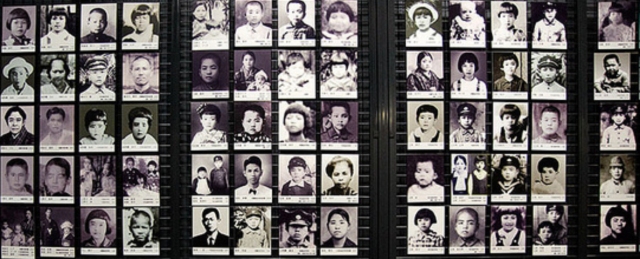Found at www.bowfin.org.
Tsushima Maru Sinking
Off the coast of Akusekijima 22 August 1944
 |
| Tsushima Maru from the USS Bowfin Submarine Museum & Park |
Survivors of the sinking were not allowed to speak of the incident under threats of extreme punishment.
The Convoy

Ships sailing in Convoy Namo 103 with Tsushima Maru, on 22 August 1944:
- Kazuura Maru (listed as Waura Maru in some sources): 6,804 tons. May later have been declared and used as a hospital ship by the Japanese government.
- Gyoukuu (source is unsure of transliteration) Maru. (Further information presently unavailable, although the ship may possibly be the 6,854 ton cargo vessel Gyoku Maru, which was sunk by USS Thresher (SS-200), at 35-05N, 124-24E on 18 September 1944.)
- IJNS Hasu (destroyer, Momi or Kuri Class); Badly damaged 16 January 1945 at Hong Kong by aircraft of TF 38; surrendered September 1945 at Tsingtao and broken up 1946 at Sasebo. (from: Warships of the Imperial Japanese Navy, 1869-1945, pages 137-138.)
- IJNS Uji (gunboat); Survived the war; surrendered August 1945 and transferred to China as Chang Chi; taken over by Communists in 1949 and re-armed by 1955. (from: Warships of the Imperial Japanese Navy, 1869-1945, pp. 118-119.)
The sinking has been the subject of many articles and books published in Japan, as well as a good number of documentary broadcasts and even an animated feature film. Memorial ceremonies are held at sea at the approximate location of the sinking, and there are monuments in Naha City, Okinawa and on Akuseki Island for those lost at sea.
Recent Findings
An investigation team from the Japan Marine Science & Technology Center (JAMSTEC) found the sunken ship on 12 December 1997, in waters 10 kilometers northwest of Akuseki Island, Kagoshima Prefecture. The ship was positively identified by Dolphin 3K deep sea detection equipment, which video taped the portions of the sunken vessel and found the ship's name painted on her hull.

Following is a translation of a Waka Poem by His Majesty the Emperor of Japan, for his Year-end Presentation in 1997 (Ninth Year of Heisei):
The sighting of wreck of the Tsushima-MaruFoundered, with lives
Of the young evacuees
Held in her embrace,
The ship has been discovered
Far down in the ocean depths.
Note of Interest
Recent Findings
The periscope photograph shown at right has appeared in publications both in the U.S. and Japan, misidentifying the vessel as Tsushima Maru. Because the attack occurred at night, between 2200 and 2230 (10:00 pm. and 10:30 p.m.), and the ship (confirmed by all accounts) sank in less than 15 minutes, this photo could not possibly be of Tsushima Maru. Furthermore, Bowfin did not take any photographs of this attack, and the vessel shown appears to be much smaller and of a different type than the 6,754 ton, 136 meter long passenger-cargo ship, Tsushima Maru.
767 Children Killed in 1944
When Tsushima Maru Torpedoed
On 22 August 1944, about eight months before the Battle of Okinawa, the Tsushima Maru, a passenger-cargo ship, was on her way from Naha, Okinawa, to Kagoshima, Kyushu, a destination that was altered to Nagasaki, also in Kyushu, on the first day at sea, the 21st. It carried 1,484 civilians, including 826 children. According to some of the survivors, the purpose, ironically, was evacuation, i.e., to move children to a safer place on one of the main islands. It was part of a convoy that included, in addition, three cargo vessels, a destroyer and a gunboat.

A portion of the photos of victims exhibited in the
Tsushima-maru Memorial Museum.
Click HERE to visit the Museum.
At around 10 p.m., the ship was hit by torpedoes fired from the USS Bowfin, which was under the command of CDR J. Corbus. In less than 12 minutes, the ship sank, killing most of the passengers, including 767 children. Only 59 children survived. Five of them shared their accounts of the incident: [Left to right] Mitsuko Itokazu, Kiyoshi Uehara, Tae Uehara, Masakatsu and Chiyo Takara.
At the time, the Japanese government forbade survivors to discuss the subject. Thus years passed before word of the tragedy got out. In the Bowfin’s original records, this kill was listed as just another “cargo” ship. In fact, it’s still listed as such in some accounts. More than 20 years after the war, after the U.S. learned about the civilian passengers aboard, the record was revised to “passenger-cargo,” and added to the vessel’s description was “unmarked” and “unlighted” at the time of the attack.




No comments:
Post a Comment